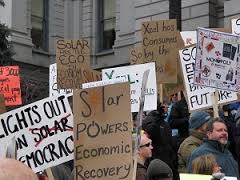Ever since the theories of Thomas Edison lost out to those of fellow energy pioneer Nikolai Tesla a century ago, the electricity industry has been dominated by centralised power.
That power has been invested not just in the size and shape of the generators – particularly of coal, gas and nuclear – and of the massive grids that have acted as their delivery systems, but also in the monopolies and oligopolies that have dominated the business of electricity, and the regulators who have served to protect those interests.

It has all been about centralised power, and has had the happy outcome of creating an industry in the shape of the preferred business model of the incumbents. It has been protected by system complexity and technology advantage that has left the sector both indispensable and unassailable.
That was, at least, until the emergence of serious competition in the form of rooftop solar and battery storage; and the emergence, since, of new innovations, smart technologies and business models. In short, a new way of doing things. Suddenly, centralised power is not as absolute as it once was.
In Australia, an industry with a cosy cabal of a few dozen generators is now facing competition from more than 1.5 million smaller rivals, as the households, business and consumers begin to generate, and now to store, their own power, and new business ideas evolve to connect the dots and challenge the incumbents.
This has already had an impact on the earnings, the outlook, and the investment plans of the generators, networks and big corporations who have seen their advantage on technology and costs rapidly deteriorating.

And now, one of the last bastions of their control over the consumer – the influence over regulatory and pricing outcomes, where complexity is king and confusion is profit – is also under attack.
A striking example of this is in Victoria, where the new Labor government wants a review into the “fair value” of solar, and an assessment made of whether the the reduced feed-in tariff – cut to just 5c/kWh this year, as recommended by the Essential Services Commission –is justified or not.
So who has Labor asked to review the ESC assessment? The ESC of course. And the solar industry and environmental groups are bashing on the door to try and break down the exclusivity that has guided such reviews in the past.
Greens MLC Greg Barber has launched a Facebook campaign – a fair go for solar – to encourage solar home-owners – and there are 250,000 of them in Victoria – to make a submission to the ESC review. He has already gotten nearly 1,500 such submissions. But still, it seems, no seat at the table.
According to Barber, the ESC had invited “stakeholders” to a meeting – held today – to discuss the ESC’s approach to the review. The meeting was to be “open”, but references to it were suddenly deleted from the website and it ended up being “invitation only”.
Such is the glacial pace of change in the electricity industry, that the ESC last December issued a 60-page report on how it would approach the review.
It has sought submissions and then will consider the matter. Then it will do the review. That might take more than a year, by which time tens of thousands of Victorian solar households will see their 20c/kWh tariff slashed to around 5c/kWh.
Barber says this is not good enough. He, and others, say that the question of distributed generation has been treated as almost “trivial” by the incumbent industry, and the issue buried under the complexity of weighty submissions.
“They turn it into a reductionist exercise, breaking it into a million bits until it is meaningless,” Barber tells RenewEconomy. And true enough, the ESC wants to split the inquiry into two – one for the “energy value” and another on “network value”. And it wants more time.
“This is the storming of the Bastille,” Barber promised. “If they want to invite stakeholders, they are going to need the Melbourne town hall, rather than a small room.”











